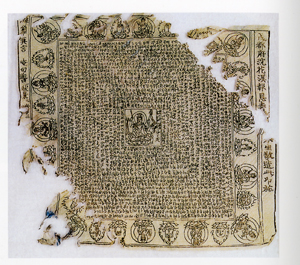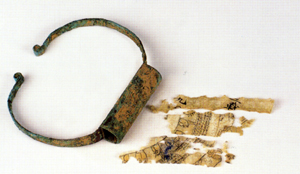|
|
|||
 |
About the Magazine | Advertising | Archives | Contact | ||
     |
|||
Chant and shadow
If the magic is in an incantation’s sound, why did medieval Chinese Buddhists write theirs down?
By definition, incantations exist out loud. They’re meant to be recited, performed, chanted; the Latin verb for “sing,” cantare, is right in the middle of the word. But for medieval Chinese Buddhists, incantations—in particular, Sanskrit spells called dhāraṇī—also held power as written speech. Believers carved them into stone pillars and cliffs. They printed dhāraṇī on silk or paper and tucked them into amulets, which they wore on their bodies and buried with their dead. Written dhāraṇī are interesting, says Buddhism scholar Paul Copp, an assistant professor in East Asian languages & civilizations, “because the best known doctrinal presentations of these spells always say you have to speak them, that they can only be effective as sound.”

Medieval Chinese often personalized printed dhāraṇī, like this “Spell of Wish Fulfillment” (above), or wore the incantations in armlets (below).

That conception arose in India, where dhāraṇī are thought to have originated and where adherents had specific ideas about the power of the ancient Vedic Sanskrit language. “In large part,” Copp says, “that was lost on the medieval Chinese,” who incorporated dhāraṇī practices into their existing traditions of religious talismans and amulets. “But there was an understanding that you had to maintain the Sanskrit, so they didn’t translate the spells.” If they altered the spells at all, “they transliterated them,” cobbling together Chinese characters that mimicked Sanskrit sounds. “So you get long strings of strange-looking Chinese text that don’t make sense in Chinese,” Copp says. “And basically they aren’t Chinese—they’re Sanskrit.”
At work on a book that expands on his Princeton University dissertation—he earned a PhD in religion in 2005—Copp studies the physical representations of two dhāraṇī popular during the Tang Dynasty, a period lasting roughly from the sixth century A.D. through the tenth. The first dhāraṇī, called the “Superlative Spell of the Buddha’s Crown,” seeks long life, favorable rebirths, and deliverance from hell. The “Spell of Wish Fulfillment,” meanwhile, covers more quotidian needs: good health, rescue from danger, easy passage for travelers, preservation in battle. “One of the clichés of Buddhism is that it’s about getting rid of your desires,” Copp says, “but if you look at Buddhist practices, many of them are about fulfilling desires.”
Spending most summers in western China examining cliff carvings, museum and temple artifacts, and paintings and manuscripts unearthed from Dunhuang’s Mogao Caves—where for more than a millennium Buddhist monks amassed sacred artworks and scriptures by the thousands—Copp is investigating how Tang Chinese believers imagined these two incantations to work.
As in India, chanting was considered essential to enacting a spell; archaeologists have discovered guides to pronunciation, Copp says, noting, “You have to get the sound exactly right.” But scholars often neglect the potency that Chinese attributed to dhāraṇī’ physical forms: “the writing of something powerful that gets transferred to the ink and the stone.” That concept, Copp reasons, falls outside the normal understanding of Buddhist devotion. Yet Tang Buddhists believed, for instance, that if dust from a dhāraṇī pillar blew onto them, or if they stood downwind from it, or stepped into its shadow, or touched it, “or even came near it,” Copp says, “then the magical effects would be the same as if they had heard the spell recited or read it aloud.” This idea, he adds, captured the imagination of Tang Dynasty poets. Commissioned to inscribe dhāraṇī pillars with a few lines of verse, they often carried the notion of “the dust and the shadow” into the literary world.
dhāraṇī pillars were fixtures of Chinese Buddhist architecture, found not only in temples but also along roads and in tombs. Reliefs of pillars were etched into cliffs. But the spells’ material incarnations were not always so monumental. Tomb excavations all over China have yielded amulets that both men and women would have worn. Printed incantations were rolled into armlets and folded into round cases resembling cosmetics compacts. “You’d wear them on your sleeve or in your pocket,” Copp says, “somewhere on the body.”
Artisans made money—“presumably for the monasteries,” he says—producing and selling dhāraṇī amulets. Printed spells often included spaces for buyers to write in their own names, and some left space for an image at the center as well. “You were supposed to draw a specific picture, or hire someone to draw it, depending on who you were and what you wanted,” Copp explains. “So if you’re a woman anticipating a difficult childbirth, the picture would reflect that.” Among the documents and manuscripts at Dunhuang, archaeologists have discovered spells still awaiting personalization, their blank spaces left empty. In other spells, Copp says, buyers’ crammed their names into too-tiny spaces. “So they seem to have been sold off the rack.”
Copp gives more attention to the written word of dhāraṇī than other scholars do. “There’s this tendency to say they’re nonsense,” he says: beyond the traditional focus on sound rather than text, scholars who study Chinese Buddhism often don’t know Sanskrit, and when the spells are transliterated into Chinese, “they look like gobbledygook.” But disregarding them as meaningless, Copp says, is “a serious mistake, if an understandable one.” He argues that these texts made sense to Tang Chinese, who knew what the spells were for and understood them to be a form of prayer. “It’s quite clear,” he says. “If you translate the Sanskrit right around where the Chinese name is written, you’ll see that it says, for instance, ‘I wish these things.’” Furthermore, some thinkers in Tang China, among them the eighth-century monk Bukong, translated the Sanskrit dhāraṇī and wrote commentaries on them. Insists Copp: “They took the spells and the syllables themselves as readable text.”
How many ordinary adherents could have done the same is hard to know. “Traditionally,” he notes, “we’ve said that except for a few highly trained monks, medieval Chinese could not read Sanskrit.” But Copp’s not so sure. People may not have had a scholastic understanding of the language, but likely they had a practical knowledge. “A lot of these terms were in common usage. In English, we use Sanskrit words—karma, dharma—and even if we don’t know Sanskrit, we know what they mean. It’s hard to imagine people chanting the same words day in and day out without asking what they meant.”
And yet dhāraṇī vocabulary is lexically different from other Sanskrit writing. “It’s spell language,” Copp says, “which is an exotic and strange version, but it’s one made strange for the purposes of chanting.” Paradoxically, the syllables’ foreignness would have deepened the incantations’ meaning and intensified their magic. “It’s like when you go to a White Sox game and you hear the crowd chanting, ‘Swing, batta, batta, swing!’” he says. “‘Batta’ is not really English, but it’s not nonsense. To enunciate ‘batter’ would lose the effect. dhāraṇī are like that.”